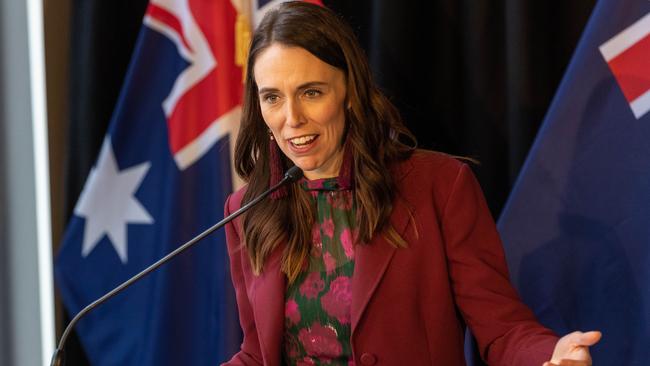
Jacinda Ardern’s Freudian slip illustrates how democratic governments have been as guilty of “misinformation” or “disinformation” as any critics of lockdowns, masks and border restrictions. For 15 months they have trotted out fear-mongering slogans about “saving lives”, “staying alert” or (in Britain) “clapping for carers” on Thursday night.
Governments have avoided context and facts that would have put people at ease, amid the cacophony of hysterical reporting of a disease that remains a negligible threat to the vast bulk of people. The Victorian government’s “Staying Apart Keeps Us Together” could have been written by the government of Oceania in George Orwell’s 1984.
It’s been a 24/7 doom deluge for more than a year, and it’s all been extraordinarily successful. The British public thought 6 per cent of the country had died from Covid-19 (4 million people) according to an August 2020 poll. In the US, two-fifths of Democrat voters and a quarter of Republican voters thought the chance of hospitalisation from contracting Covid was more than 50 per cent, when it is between 1 and 5 per cent.
Only propaganda can explain how in Washington DC, weeks after requirements for masks were removed, the majority of people are still wearing them outside.
And it is worse in Australia, where few have first-hand experience of Covid, and most support rolling lockdowns and even the construction of special-purpose quarantine facilities – unthinkable in 2019.
Tedros Ghebreyesus, the head of the WHO, in August said “the mask has come to represent solidarity”. They are as much about keeping people scared as “safe”. As recently as December the WHO conceded “at present there is only limited and inconsistent scientific evidence to support the effectiveness of masking of healthy people in the community”.
Friends ask what it’s like to be in a Covid-ravaged country. Well, in two months I’m yet to see evidence of a great pandemic – no sirens, no one dropping dead in the street as the Chinese Communist Party’s fake videos from early last year would have had us expect.
An extra 800,000 deaths of despair caused by the hysteria and lockdown-induced spike in unemployment are in the pipeline over the next 15 years, though, according to 2020 research from Duke and Harvard universities, which will attract next to zero media coverage.
“The Covid-19 epidemic may prove to be the biggest campaign of fear the UK, and the world, has ever seen,” writes English journalist Laura Dodsworth in her excellent new book A State of Fear. In almost 300 pages she lays out the extent to which the British government — armed with a popular new field of economics, “nudge theory”, which argues governments must “nudge” inherently irrational citizens to avoid making “poor choices” — sought to scare citizens into compliance.

“The use of fear to create compliance is ethically dubious and, at the very least, warrants public debate,” she concludes, revealing how the “weaponisation of fear” saw many of the most vulnerable die alone, terrified, in nursing facilities kept away from their loved ones.
A British government expert committee advised in late March that “a substantial number of people still do not feel sufficiently personally threatened; it could be that they are reassured by the low death rate in their demographic group, although levels of concern may be rising”.
A few days later Covid-19 became the “invisible killer” in a speech by British Prime Minister Boris Johnson that set the tone globally. Fifteen months on, the virus is an “absolute beast” according to Victoria’s chief medical officer, doing his best to scare people into compliance with the state’s ridiculous series of lockdowns.
The German government “collaborated to bring images of people choking to death at home, and to inflict fear and guilt on children, in order to make the population follow rules for an epidemic which had been deliberately exaggerated”, Dodsworth reveals.
It didn’t have to be like this. In March last year the British government stressed Covid-19 was a “very mild illness for the vast majority of people”, based on the information available from Italy. If governments had stuck with that information, confirmed by all that ensued, we could have avoided a doom loop of fear-induced draconian policies, where politicians, whatever their private thoughts, felt compelled to stick with “emergency orders” and health diktats. It was more shove than nudge.
If the media can be excused for sensationalising Covid-19 in the interest of clicks and profit, democratic governments can’t, especially in an age of social media where alternative viewpoints have been censored.
Harvard professor of medicine Martin Kuldorff was suspended from Twitter for saying children didn’t need to be vaccinated against Covid, and was later banned for suggesting “public-health officials/scientists must always be honest with the public”.
“As fear finally melts away we will be able to confront our frailties and strengths, as citizens, scientists, journalists and politicians,” Dodsworth writes.
It’s doubtful Covid-19 justified propaganda on the scale and duration we’ve seen. If it has helped governments implement their policies in the short run, in the long run it will erode trust in public institutions.
Are they trying to nudge you, or telling you the truth? Democratic government is meant to be built on the idea that individuals make their own choices.
The coming years will highlight the yawning gaps between reality and propaganda, as researchers gradually feel more confident to criticise the manufactured narrative of plague.
It’s sobering that more of us didn’t do our own research. Abraham Lincoln allegedly once said you can’t fool all the people all the time. It seems you can certainly fool most of them for a long time.








When the New Zealand Prime Minister back in March scolded a 21-year-old for going to the gym after his Covid-19 test and ignoring “a full two-week period of sustained propaganda” — yes, she said that — she was right about one thing. Not since World War II have we endured so much propaganda. But it’s been a lot longer than two weeks.